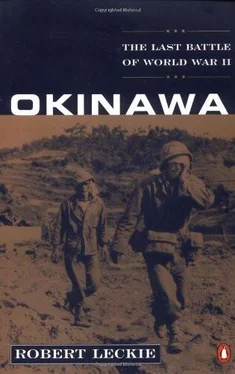Ugaki had a second problem in organizing his forthcoming kikusui attacks: how to strike a balance between under-training and over-training his kamikaze. Overtraining a pilot in the sense of turning him into a skillful combat flyer would be a wasted effort when all that was needed was to guide an obsolete aircraft to its target and then crash-dive it. But suicide attacking wasn’t that simple, especially in the North Pacific springtime when the weather was so variable, with conflicting wind currents, poor visibility, and low ceilings. In such weather even an experienced pilot could become lost. For a rookie pilot to keep a bomb-loaded crate on a direct course was not enough, for he still might not find his target. In such unreliable planes, engine trouble was frequent, and the student pilot needed to be trained enough to return successfully to base. But a new recruit would not emerge as a qualified suicider until months later. This requirement put an unbearable burden on Ugaki’s attempt to build up a powerful air armada; the suicide tactic for which this force was being formed was not only innately self-destructive but also time-consuming. Japan in the spring of 1945 could not afford to lose more months of what had become a fast-vanishing resource. Finally, the American seaborne aerial attacks on Kyushu and Formosa, as well as the Marianabased B-29 strikes on Kyushu and to a lesser degree of MacArthur’s Fifth Air Force on Formosa, along with the willingness of the suicide-saviors to take their own lives, had left Ugaki with nothing like the minimal four thousand aircraft he needed to destroy or cripple Spruance’s Fifth Fleet. That was one reason why Ugaki’s airplanes did not immediately strike the Americans the day the invasion began, and it was not until that very day that Admiral Toyoda in Tokyo ordered Kikusui 1 to be launched on April 6.
That morning dawned overcast, with northeast winds whipping a mackerel sea into a white-crested gray mass, pushing layers of smutty clouds scudding along at altitudes of three thousand to seven thousand feet. It was good kamikaze weather, providing them with excellent cover. Yet Rear Admiral Toshiyuki Yokoi, whom Ugaki had placed in charge of the kikusui attacks, waited until around noon before sending his squadrons aloft, hoping thereby to catch patrolling American fighters at that most dangerous moment of refueling—either on carrier decks or the aprons of Yontan and Kadena Airfields. It was a good idea that may have come to Yokoi by his recollection of how Yamamoto’s carriers at Midway were struck at exactly that moment. But there would be no such surprise, for Spruance’s task force commanders had long since installed the routine of keeping defensive fighter patrols aloft from sunup till sundown. Nor did Yokoi’s ruse of dropping “window”—aluminum strips to create false blips on radar screens to lure American fighters away from the impact area—for radar operators picked them up almost as soon as they were dropped.
Both Spruance and Turner were aware that a massive enemy aerial strike would arrive that day, not only from warnings from intelligence officers reading messages in the broken Japanese code, but through combat instincts sharpened by years of experience: once the enemy had collected enough planes, he would strike. To thwart him, Turner had deployed a wide circle of sixteen radar picket destroyers like irregular-length spokes in a wheel winding around Okinawa and some of its surrounding islands. These spokes extended from “Point Bolo,” a reference point on that Zampa Cape he had so ardently desired, and which had been presented to him by the Sixth Marine Division. Each radar picket could give early warning of an enemy attack, and also carried a five-member radar direction team trained in vectoring patrolling fighters onto “bogies,” unidentified targets. As might be expected, the pickets would become prime targets of the attacking enemy, especially Radar Picket Stations 1 through 4, on duty on an arc about thirty miles north of Okinawa—the point over which enemy planes from Kyushu were most likely to fly.
On that morning of April 6 all was quiet in the skies above the Great Loo Choo, although Japanese scout planes in the northern Ryukyus had discovered TF 58’s Fast Carrier Forces and brought hundreds of fighters and bombers down on them. Half of them missed their target and flew on to Okinawa while the other half zeroed in on Rear Admiral Joseph “Jocko” Clark’s Task Group 58.1. They hit the carrier Hancock and two destroyers, and a kamikaze Judy bomber almost sent the big flattop Bennington to a watery grave. Plunging at the American’s stern, the suicider was shot to bits by all of Bennington’s ack-ack that could be brought to bear. When the Judy exploded astern, parts of her engine fragments fell in a shower on the carrier, temporarily disabling her rudder.
Later in the day Yokoi’s fighters arrived off Okinawa’s airfields and were intercepted by American fighters on patrol above them. At three o’clock, with the Yankee fighters presumably driven from the area, the suiciders struck. They dove on the pickets of the radar screen and that forest of masts in Hagushi Anchorage. Some 200 of them came plummeting down for five hours until darkness veiled the sea or magnified the funeral pyres of stricken American ships.
Destroyers Bush and Colhoun were sunk, Colhoun hit and staggered so frequently that she had to be abandoned and sunk by friendly fire. The ammunition ships Logan Victory and Hobbs Victory also went down, creating a temporary ordnance shortage for the Tenth Army. Nine other destroyers were damaged, as were four destroyer-escorts and five mine vessels.
It was an impressive day’s work for the first sally of the kikusui even though they had lost 135 planes. But the kamikaze reports were as usual exaggerated, rivaling even those of the Thirty-second Army, claiming thirty American ships sunk and twenty more burning. Such bloated estimates so encouraged Admirals Ugaki and Toyoda that the Navy chief began to think that perhaps the world’s first suicide battleship—great Yamato —might really stagger the Americans during its one-way voyage to Okinawa and eternal glory.
Yamato —named for the clan generally credited with founding the Japanese nation—was not only the most powerful battleship afloat, but also the most beautiful. On April 6, while hundreds of kamikaze roared down from the north, Yamato came trailing afterward in the spreading white majesty of her mighty bow wave.
Yamato had survived the Battle of Leyte Gulf, where her sister Musashi had not. Yamato could outshoot anything in the U.S. Navy. She had nine 18.1-inch guns firing a projectile weighing 3,200 pounds a distance of 45,000 yards, compared to the 2,700-pound shell and 42,000-yard range of the American 16-inchers. She displaced 72,809 tons fully laden, and drew 35 feet. She was 863 feet long and 128 in the beam. She could hit 27.5 knots at top speed or cruise 7,200 miles at 16 knots. And she was sortying out of the Inland Sea for Okinawa with only enough fuel in her tanks for a one-way voyage.
If soldiers and tanks, fliers and airplanes, sailors and boats could be enrolled in the ranks of the suiciders, it was logical that admirals and dreadnoughts should follow. There were three admirals coming with Yamato, and the light cruiser Yahagi and eight destroyers. There might have been more of them and more warships, but Admiral Toyoda could scrape up only 2,500 tons of fuel for the venture. Although Toyoda had high hopes for the success of the kikusui, he could not have regarded Yamato’s sally as anything but a forlorn hope; he gave Rear Admiral Seichi Ito, commanding this Surface Special Attack Force, only two airplanes for protection. If it was the good fortune of Yamato and company to reach Okinawa unscathed, or at least with the huge battlewagon and a few other ships intact, their mission was to fall like wolves upon the sheep of the American troop transports and supply ships in the Hagushi Anchorage, and then, with their fuel almost exhausted, beach themselves to support a sally by Ushijima’s Thirty-second Army with all their guns led by Yamato’s 18-inchers. At three-twenty on the afternoon of April 6, exactly twenty minutes after the first of the Floating Chrysanthemums dove on the Hagushi targets, Yamato and her escorts shoved off from Tokuyama.
Читать дальше










